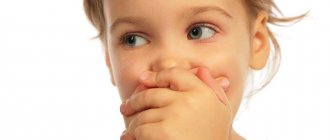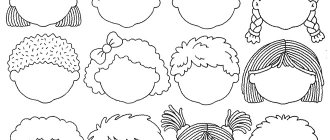In the first six months, the baby simply craves close communication. Don't deny him this, and very soon the baby will start walking. This is the first, initial stage of speech development. Talk to your child more often!
Source: Shutterstock
Up to six months, your baby needs a lot of tactile, visual, auditory, and motor sensations. He learns to distinguish the voices of people around him, smells, touches, faces. But even the baby needs direct contact with his mother: skin to skin, eye to eye. Interaction is important to him. Only it ensures the mental and speech development of the child.
With optimism!
The baby is initially charged with positive emotions. He eagerly absorbs new knowledge. But nevertheless, sometimes she cries. New parents are worried, but screaming and crying are not necessarily a signal of distress.
Speech development: 6 ways to help your child speak
Cooing
The baby begins to coo and smile to attract the mother's attention. He is trying to establish dialogue, establish social contact. The baby trains speech, learns new sounds, and develops intonation.
What does it sound like
When a baby gurgles, vowel sounds predominate in the baby’s speech: “o”, “u”, “a”, “e”, “ua”. Because of the guttural pronunciation, parents hear the cherished “aguuu”.
Cooing is the initial stage of speech acquisition, which needs to be supported and developed. The baby tries to repeat sounds after adults, so they need to be pronounced more often. First, the baby will listen and remember, and then begin to repeat.
When does it start
When a baby masters cooing depends on the level of development of the vocal apparatus, hearing and vision.
If there are no pathologies, then the newborn begins to coo at the age of 4–6 weeks. This stage lasts only 3–4 weeks, smoothly transitioning into the next form of communication.
Around the same time, at the age of 1–1.5 months, you can notice the first real smile on the baby’s face. Spontaneous ones appear as early as 1–2 weeks. However, children begin to smile consciously at six months, not earlier.
First ASU
The sounds of pleasure, as we said, are also of a reflex nature. Usually after feeding or after you have changed a wet or dirty baby, you hear the sounds of contented grunting, satisfied grunting, hooting, humming or initial babbling. Among them, front vowels and back consonants are more common.
Unlike screams, they do not have a nasal connotation.
Experts believe that speech develops faster when hearing is stimulated by sounds of pleasure. The most important among them are humming and babbling.
Booming
The baby begins to walk and smile after he learns to coo. This is how he tries to attract mom’s attention and train his voice. Sometimes this happens involuntarily when the baby diligently examines the toy.
What does it sound like
Humming is a more complex speech form than hooting. So named because the baby makes sounds similar to those of a pigeon. Consonants are added to vowel sounds - “k”, “x”, “g”. In combination with vowels, it turns out to make the following sounds - “gyy”, “guuu”, kyyy”, “aguuuu”, “khyy”, “geeee”.
The duration of the party depends on the baby’s mood and the parents’ reaction. If mom likes this kind of “communication,” then the baby begins to “speak” even louder. Alone, the walking is less intense. In the presence of his mother he becomes active.
When does it start
The child begins to walk at 1.5–2 months. The duration of this stage is 4–5 months. The peak occurs at three months of age.
The baby begins to coo and coo at approximately the same time. But the cooing doesn't last long.
What does a baby's cry mean?
- A demanding invitation to communicate with people around you.
- Training for the lungs (when crying, they open up and gain volume).
- Training for children's lips, tongue, cheeks, soft palate.
- Checking the functioning of the vocal cords and demonstrating vocal abilities.
- Practicing strength, modulation, and timbre of the voice.
- Limit your screamer's training to 1 minute. Be sure to react, approach, if necessary, calm down.
No stress!
Now the baby is programmed to recharge. He completely absorbs your attention and love. Mom is having a hard time. And it’s not just about the daily routine and nightly vigils near the baby’s crib. Mommy herself needs communication and relaxation. Organize your life so that this works out.
Babbling
This is the stage of pre-speech development following humming, which precedes the appearance of new words and phrases.
What does it sound like
The child constantly practices the acquired skill of humming, beginning syllables with labial sounds - “b”, “m”, “p”. He gets “ba, ma,” “pa,” “ta.” He babbles to himself when he is busy playing, exploring his own capabilities. Sometimes uses babble to attract parents' attention.
When does it start
The baby starts babbling at 4–5 months, cooing syllables at 6–7 months, and at 8.5–9 months he repeats the intonation and sounds of adults. Closer to one year, the baby speaks its first words.
It is from babbling that words are born.
Baby's cry - initial attempts at communication
All vocal reactions of the child can be divided into two groups:
- reflex sounds,
- socialized sounds.
Among the reflex ones, screams and sounds of pleasure are distinguished.
Already by the 2nd month of life, the baby’s cry begins to acquire more and more new shades, and by 3 months the mother can already determine why the baby is screaming: whether he is hungry, whether he is wet or something hurts. In all cases, the cry has its own characteristics.
In a healthy baby, the intonation coloring of a cry is clearly expressed starting from the 3rd month of life. In children who have suffered birth trauma, asphyxia during childbirth and other pathological conditions, the intonation features of a cry may be absent. The voice of such children is quiet and monotonous.
Disturbances in the development of intonation coloring of a cry are often combined with feeding difficulties. The baby may suck poorly, choke and choke during feeding, and sometimes milk leaks out of his nose. Such a baby should definitely be shown to a neurologist.
In the first months, the baby’s cry is dominated by vowel-like sounds that have a certain nasal connotation. These are sounds like “e”, “ay”. Sometimes the sounds resemble the consonants “g”, “k”, “n”. But since they are of a reflexive nature, they are not considered the predecessors of phonemes.
And yet, by pronouncing these sounds, the baby learns to coordinate the work of the respiratory, phonatory and articulatory muscles. The feedback between articulatory movements and their auditory perception also develops.
We recommend that you listen carefully to the baby's cry. The nature of the cry has important diagnostic significance. In a healthy baby of the 2nd month of life, the cry is loud, clear, with a short inhalation and an extended exhalation.
Children with damage to the central nervous system, who later develop speech disorders, may not cry in the first months. Either their scream is piercing, or, conversely, very quiet. As you exhale, the child sobs or screams. A significant nasal tone in the voice is also a sign of trouble.
If in a healthy baby the intonation features of a cry are formed by 3 months of life, then with organic damage to the central nervous system, for example, with cerebral palsy, the cry remains monotonous and inexpressive.
At 2-3 months, while crying in a healthy child, general uncoordinated movements of the arms and legs begin to intensify. The first tears appear. In addition, if during the newborn period the child screamed only from cold, hunger, discomfort and pain, then from 2 months he begins to scream indignantly if the mother stops communicating or changes his body position. From this age, a child often screams before going to bed from overexcitement.
Reasons for the lag
If the baby is silent, repeats the same type of sounds, or lags significantly behind his peers (more than 4-5 months for boys and 2-3 for girls), then he is diagnosed with delayed speech development.
The reasons are medical and social:
- neurological disorders that arose against the background of hypoxia, asphyxia, difficult childbirth, infectious processes, brain injuries;
- deep prematurity;
- suffered severe infectious diseases;
- hearing loss;
- lack of communication;
- mental trauma;
- uncertainty of hand dominance (right-handedness or left-handedness);
- heredity.
Girls and boys: gender characteristics of speech
It is no secret that girls are somewhat ahead of boys in development, including in the matter of oral speech. The famous teacher I. Podlasy in his textbook “Pedagogy” explains it this way:
- from birth, girls have an increased interest in people and faces more than boys;
- parents pay more attention to girls, including talking to them longer and cooing to them;
- girls acquire motor skills earlier and master fine motor skills;
- girls remember more words and build associative series more easily;
- Boys concentrate worse.
Girls speak their first conscious words at about ten months, while boys pronounce them at the age of 11-12 months.
Doctors consider not only the mental maturity of the baby, but also point to somatic factors. In particular, the level of development, according to doctors, is also influenced by hormonal status.
Is it possible to help a child?
If a child does not start to gurgle not because of health problems, but because he is lazy or does not understand how to do it, you can teach him.
Communication
Even if the baby cannot speak, you need to communicate with him, and constantly. It is important to discuss every action, this contributes to the development of the speech apparatus.
Parents can stimulate the baby to hum, for example, when they are the first to start a sound dialogue. It is necessary to pronounce sounds clearly, show how to form your lips and tongue correctly. This should be done at a distance of no more than 30 cm from the baby so that he can see everything.
The second method of stimulation is repeating all the sounds after the baby. This will teach the child to imitate the speech of adults.
During a conversation, it is important to smile, say kind words, praise, and stroke the baby.
Palm massage
Finger exercises together with massage improve sensory-motor development. The palms should be massaged gently, without much effort. Movements:
- Using your thumb, massage the center of your palm clockwise, gradually increasing the radius.
- Rub your palm against your palm.
- Using your index finger and thumb, applying slight pressure, move from the base to the tip of each child's finger.
- Rub the pads.
The massage lasts 5–7 minutes.
Nursery rhymes and songs
They can be used for finger games or pronounced just like that. Children's songs, rhymes, nursery rhymes bring a smile, delight and stimulate cooing.
Good books for babies under one year old can be bought at any bookstore. Choose publications in which poems and nursery rhymes are selected by age - the smaller the child, the simpler they should be.
Useful video with games for baby development from 0 to 3 months
Finger games
Speech development depends on fine motor skills of the fingers. Here are examples of finger games that will help the baby “talk”:
- "Magpie-crow." While reciting the nursery rhyme “The magpie-crow was cooking porridge,” move your index finger across your palm, and then bend the child’s fingers one by one.
- "Pads." Use your index finger or thumb to press on the child’s fingertips, saying: “This pad is for grandma, this one is for grandpa, etc.”
- "Okay." Clap the little ones' hands.
- "Let's feed the bird." Hold your fingers in the form of a beak and “peck” imaginary grains in the baby’s palm.
You need to play when the baby is in a good mood; you cannot force him.
What are the first words of babies?
Domestic and foreign researchers of children's speech describe a certain pattern in the order of learning the first words and their meanings. There is a certain set of words that basically all children learn. But depending on individual characteristics, the order of words may be different.
Usually all parents wait for the child to say the first word “mom” or “dad”. But many children, even before they say “mom,” have already uttered several words that parents do not consider words: (“am-am” - I want to eat; “av-av” - dog and others).
From the very beginning, babies begin to talk about what they want, see and feel (“I want”, “no”), and not about what they know and think. Researchers of children's speech identify the main groups of words that young children begin to pronounce. Here are some examples of children's words:
- People surrounding the child (mother, father, grandmother, aunt),
- Animals and birds (meow, ki, kitty, aw-aw, ava, mu),
- Food (um-am, yum-yum, drink, soup, tea),
- Movements (top-top),
- Sleep (ah-ah, bye-bye),
- Actions (give, on, knock-knock, more),
- Conditions (bo-bo - it hurts),
- Consent (yes, no),
- Place (there)
- Transport (bb - car),
- Items in the house (aka - telephone, tick-tock - clock),
- Condemnation for actions (ay-ay),
- Farewell (bye-bye).
In their development, babies go through a number of stages when mastering certain skills (for example, before a child learns to walk independently, he takes his first steps against a support or with the support of an adult). This is how a child learns to speak. Before the baby utters his first words, he will learn to pronounce individual sounds, sound combinations, and only then words, i.e. There will be a period of babbling, humming, and first words.
If a child begins to coo and wail, and then stops
If the baby starts to gurgle, but after a while becomes silent, then there is no need to worry. This break may be required to improve speech, for example, to master syllables. The crowing resumes, but it is no longer the same as before, but more intense, with intonation.
Sometimes the reason for stopping partying can be severe stress, fear, or neurological disorders. If you do not help the child, this becomes the cause of delayed speech development.
To resume croaking, you need to show the baby to a pediatrician, and then, if necessary, to a neurologist or ENT specialist. If there are no deviations, then active communication, massage, and games will help.
All infants gurgle because they do not yet know how to talk. This is preparation for speech, so maximum attention should be paid to its development.
Photo: ru.freepik.com
Useful video about speech development in a child
List of sources:
- Sapozhnikov Ya. M., Cherkasova E. L., Minasyan V. S., Mkhitaryan A. S. Speech disorders in children. Pediatrics. Journal named after G. N. Speransky. 2013; 92(4):82–87.
- Asmolova G. A., Zavadenko A. N., Zavadenko N. N., Kozlova E. V., Medvedev M. I., Rogatkin S. O., Volodin N. N., Shklovsky V. M. Early diagnosis of disorders speech development. Features of speech development in children with consequences of perinatal pathology of the nervous system. Guidelines. M.: Union of Pediatricians of Russia, Russian Association of Perinatal Medicine Specialists. 2014. 76 p.
- Arkhipova E.F. Speech therapy work with young children. M., 2007.
- Gromova O.E. Methodology for forming the initial children's vocabulary. M., 2005.
Author
Oksana Belokur
Pediatrician
Share











